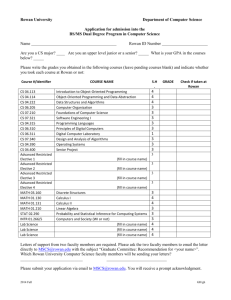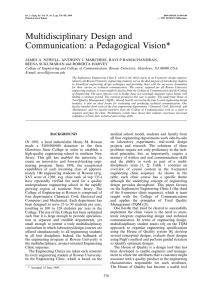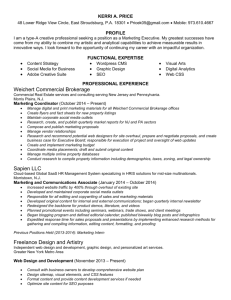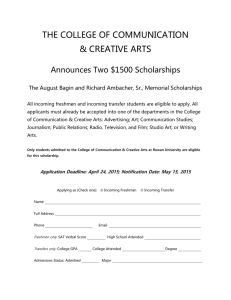Integration of Multidisciplinary Design and Technical Communication: An Inexorable Link
advertisement
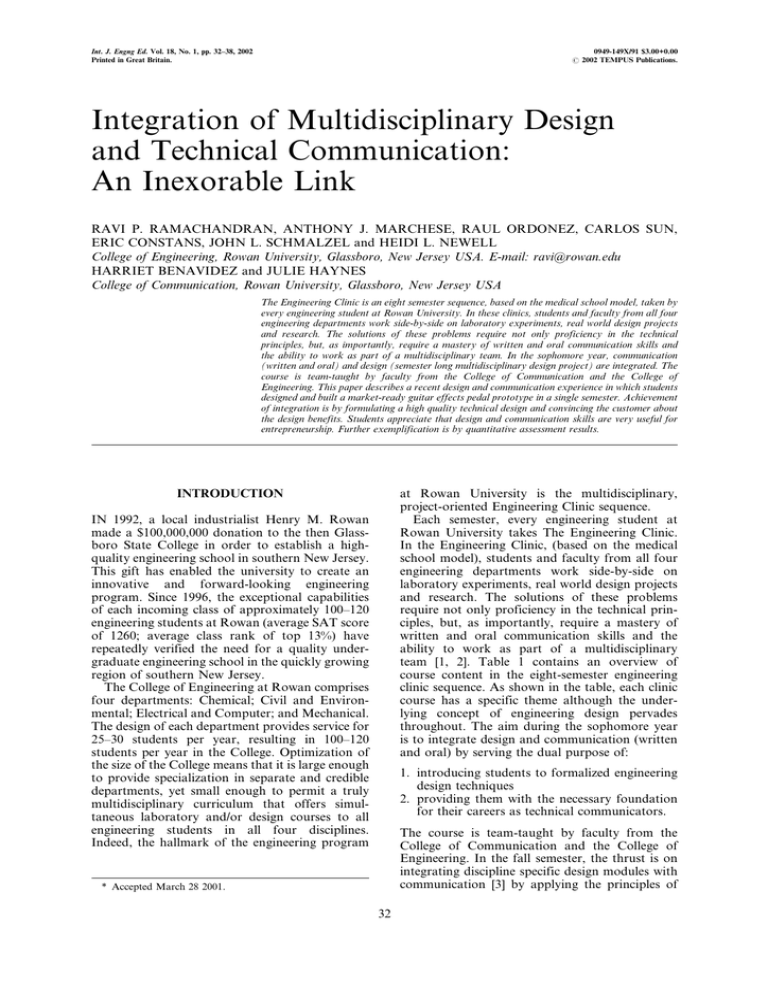
Int. J. Engng Ed. Vol. 18, No. 1, pp. 32±38, 2002 Printed in Great Britain. 0949-149X/91 $3.00+0.00 # 2002 TEMPUS Publications. Integration of Multidisciplinary Design and Technical Communication: An Inexorable Link RAVI P. RAMACHANDRAN, ANTHONY J. MARCHESE, RAUL ORDONEZ, CARLOS SUN, ERIC CONSTANS, JOHN L. SCHMALZEL and HEIDI L. NEWELL College of Engineering, Rowan University, Glassboro, New Jersey USA. E-mail: ravi@rowan.edu HARRIET BENAVIDEZ and JULIE HAYNES College of Communication, Rowan University, Glassboro, New Jersey USA The Engineering Clinic is an eight semester sequence, based on the medical school model, taken by every engineering student at Rowan University. In these clinics, students and faculty from all four engineering departments work side-by-side on laboratory experiments, real world design projects and research. The solutions of these problems require not only proficiency in the technical principles, but, as importantly, require a mastery of written and oral communication skills and the ability to work as part of a multidisciplinary team. In the sophomore year, communication (written and oral) and design (semester long multidisciplinary design project) are integrated. The course is team-taught by faculty from the College of Communication and the College of Engineering. This paper describes a recent design and communication experience in which students designed and built a market-ready guitar effects pedal prototype in a single semester. Achievement of integration is by formulating a high quality technical design and convincing the customer about the design benefits. Students appreciate that design and communication skills are very useful for entrepreneurship. Further exemplification is by quantitative assessment results. at Rowan University is the multidisciplinary, project-oriented Engineering Clinic sequence. Each semester, every engineering student at Rowan University takes The Engineering Clinic. In the Engineering Clinic, (based on the medical school model), students and faculty from all four engineering departments work side-by-side on laboratory experiments, real world design projects and research. The solutions of these problems require not only proficiency in the technical principles, but, as importantly, require a mastery of written and oral communication skills and the ability to work as part of a multidisciplinary team [1, 2]. Table 1 contains an overview of course content in the eight-semester engineering clinic sequence. As shown in the table, each clinic course has a specific theme although the underlying concept of engineering design pervades throughout. The aim during the sophomore year is to integrate design and communication (written and oral) by serving the dual purpose of: INTRODUCTION IN 1992, a local industrialist Henry M. Rowan made a $100,000,000 donation to the then Glassboro State College in order to establish a highquality engineering school in southern New Jersey. This gift has enabled the university to create an innovative and forward-looking engineering program. Since 1996, the exceptional capabilities of each incoming class of approximately 100±120 engineering students at Rowan (average SAT score of 1260; average class rank of top 13%) have repeatedly verified the need for a quality undergraduate engineering school in the quickly growing region of southern New Jersey. The College of Engineering at Rowan comprises four departments: Chemical; Civil and Environmental; Electrical and Computer; and Mechanical. The design of each department provides service for 25±30 students per year, resulting in 100±120 students per year in the College. Optimization of the size of the College means that it is large enough to provide specialization in separate and credible departments, yet small enough to permit a truly multidisciplinary curriculum that offers simultaneous laboratory and/or design courses to all engineering students in all four disciplines. Indeed, the hallmark of the engineering program 1. introducing students to formalized engineering design techniques 2. providing them with the necessary foundation for their careers as technical communicators. The course is team-taught by faculty from the College of Communication and the College of Engineering. In the fall semester, the thrust is on integrating discipline specific design modules with communication [3] by applying the principles of * Accepted March 28 2001. 32 Integration Of Multidisciplinary Design And Technical Communication 33 Table 1. Overview of course content in the eight-semester Engineering Clinic sequence. Year Freshman Sophomore Junior Senior Engineering Clinic Theme (Fall) Engineering Clinic Theme (Spring) Engineering Measurements Total Quality Management and Technical Writing Product Development Multidisciplinary Capstone Design and Development Project Total Quality Management (TQM) [4, 5]. The focus of this paper is on the integration of communication with a semester long multidisciplinary design project during the spring semester Sophomore Engineering Clinic II (the fourth of the eight semester clinic sequence). The design project is to build a guitar effects pedal. The theme is entrepreneurship in that students must be able to persuade a consumer to buy their product. This requires an excellent design and communication with both technical and non-technical people. MOTIVATION In the modern technological world, many higher education institutions recognize that an effective engineering education can no longer focus solely on the technical aspects of the curriculum, but must also provide training in both oral and written communication. Indeed, the ability to think critically and analytically (activities essential to an engineer) depends in great measure on the ability to communicate ideas in a structured and clear manner [6]. A curriculum that requires students to interact in productive and efficient ways can aid the development of communication skills that students need. In particular, emphasis on the ability to function as part of a team is of key importance. Teaming skills are lacking in most students and faculty in many education institutions. Achievement of Team skills is not possible within a single course, but should be integrated into the entire engineering curriculum [7]. Furthermore, success for team function depends on the degree of familiarity and comfort of students with interdisciplinary work [8], which makes it a desirable feature of a curriculum to encourage and facilitate such interchanges of knowledge and ideas, as is done at Rowan University. In parallel with the increased emphasis on communication and teaming skills, there is a trend in education to shift to a so-called `student centered' education paradigm [9] that gives students more control and expects them to take a more active role in their education. Integration of this idea with Rowan University's educational objective easily becomes possible in the Sophomore Engineering Clinic course, where teamwork, design and product-oriented material, together with the emphasis on education, can help enhance the students' active participation in their own learning and development as engineers. Educators Competitive Assessment Laboratory Entrepreneurship and Public Speaking Product Development are recognizing that design as a formal part of the undergraduate curriculum, is not only important to help achieve a more student centered education, but also to prepare engineers better for the demands to be placed upon them when entering industry [10]. Over the last decade there has been a growing effort across universities in the United States to increase the design content in the engineering curriculum [11, 12, 13]. It is of special importance to note that early design courses can provide a rich introduction to the engineering world and enhance the student's comprehension of engineering principles and methods [14]. This is one of the motivations for the Sophomore Engineering Clinic at Rowan University. There are close links between the themes of design and communication at Rowan. In Sophomore Engineering Clinic II, the emphasis is on oral communication and design for consumer or customer benefit. Students not only come up with an excellent technical design that is sensitive to customer needs but also develop the communication skills necessary to convince potential customers that their design is the `best'. This is a key concept in our attempt to teach entrepreneurial, business and economic skills that are essential for any engineer in today's marketplace. This paper describes a specific example of a design and development project completed in Sophomore Engineering Clinic II, requiring the design, development, testing and rapid prototyping of a guitar effects pedal. THE GUITAR EFFECTS PEDAL In the Sophomore Engineering Clinic II, each student takes part in a sixteen week multidisciplinary design project. In the last 3 years, sophomore engineering students from each of the four departments have participated in semester-long multidisciplinary design projects such as: landfill design; baseball stadium design; assistive technology for the disabled; design and development of a non-destructive aircraft inspection device [15]; and design and development of a guitar effects pedal (described in this paper). The following were the objectives for the guitar effects project [16]: 1. Design, develop, test and build a real electromechanical product. 2. Organize your product development team into a company structure and consider the intellectual property issues, economic issues, marketing 34 R. Ramachandran et al. Fig. 1. Assembly drawing of a guitar effects pedal designed by students. strategy and competitor products associated with the development of your product. 3. Culminate the project by rapid prototyping a fully operational device, ready for mass production. Each product development team consisted of a company structure of 4 students. Division of duties was approximately as follows: 1. Project Leader. This position focused on the overall logistics, engineering economics and management of the web page. 2. Marketing Manager. This position was the only position that required an interest in music so that the product focused on the customer. 3. Mechanical Engineer. This position required the use of Pro/ENGINEER to perform solid modeling, stress analysis, rapid prototyping and manual machining. 4. Electrical Engineer. This position required electronic bread boarding, design capture using PSPICE and rapid PCB prototyping using Quickcircuit. Classroom instruction included simulation of sound effects and three-dimensional solid modeling using ProEngineer. Simulated sound effects involved the use of MATLAB [17] software in the digital domain, with construction of circuits with operational amplifiers and diodes and their simulation using PSPICE for the analog domain[18]. The students build on the competitive assessment skills acquired in the Freshman Engineering Clinic II course [1, 19, 20] and conduct an assessment of existing guitar effects pedals before designing their own prototypes. The deliverables of the project included: 1. Company web page: The team web page was the 2. 3. 4. 5. 6. 7. primary form of communication amongst team members, between the team and instructors. Company portfolio: Each team maintained a portfolio that contained hardcopies of all technical material related to the project. Weekly progress design reports: Each report outlined all of the company activities and appeared on the company web page. Mid-semester design report and presentation: The mid-semester report and presentation described the proposed final design in detail and focused on customer benefits. Mid-semester Alpha Prototype: The Alpha Prototype consisted of a functioning breadboard using commercial-off-the-shelf (COTS) items and a generic enclosure. Final semester design report and presentation: The final design report and presentation described the actual final design in detail and focuses on customer benefits. Final semester Beta Prototype: The Beta Prototype is the market-ready device, built using the stereolithography machine, QuickCircuit and COTS. Figures 1 and 2 show a 3D assembly drawing of an effects pedal and a photo of several completed guitar effects pedals designed and built by sophomore engineering students. The unique set of resources in place at Rowan that enable undergraduate students to engage in rapid product development meant that development of the prototype effects became achievable in only one semester. The Competitive Assessment Laboratory, funded by the National Science Foundation (NSF) features dedicated test stations for the complete engineering assessment of consumer products. The stereolithography laboratory (also funded by Integration Of Multidisciplinary Design And Technical Communication 35 Fig. 2. Completed guitar effects pedals designed by the students. NSF) has created a rapid prototyping center that features: ASSESSMENT AND COURSE EVALUATIONS . a 3D systems SLA±250 stereolithography machine; . an Actua 2100 multi-jet modeling (MJM) rapid concept modeler; . and a QuickCircuit rapid circuit prototyping machine. Quantitative assessment results in the form of course evaluations taken over a sample of 60 sophomore engineering students appear in Tables 2, 3 and 4. Table 2 shows that students themselves feel more confident in speaking effectively after taking the course. Also, Table 2. Student self-assessment results. 1: Poor; 2: Fair; 3: Average; 4: Above Average; 5: Excellent. Question or Statement 1 (%) 2 (%) 3 (%) 4 (%) 5 (%) Mean Standard Deviation Median Students self-rated ability to speak effectively before taking the course Students self-rated ability to speak effectively after taking the course How well did `Public Speaking' help in oral communication in the engineering project? Overall, how well did the Sophomore Clinic II course help the student to present effectively? After taking the course, how prepared is the student to deal with new situations (topics, audiences, etc.) in which the student will have to decide how and what to present? 15.0 30.0 38.3 15.0 1.7 2.58 0.98 3.00 0.0 0.0 28.8 47.5 23.7 3.95 0.73 4.00 1.8 5.3 26.3 40.4 26.3 3.84 0.94 4.00 5.0 1.7 28.3 46.7 18.3 3.72 0.96 4.00 1.7 0.0 20.0 53.3 25.0 4.02 0.72 4.00 Table 3. Learning style assessment results. 1ÐAutonomous/independent. 2ÐMostly autonomous/independent, but with some direction; 3ÐA blend of styles (some autonomous, some guided); 4ÐMostly traditional lecture/guided, with some independence; 5ÐTraditional lectures guided by the professor. Question 1 (%) 2 (%) 3 (%) 4 (%) 5 (%) Mean Standard Deviation Median Where, on the following scale, would you rate the style of learning in your engineering project? What style do you prefer? 6.9 34.5 50.0 6.9 1.7 2.62 0.79 3.00 7.0 21.1 59.6 10.5 1.8 2.79 0.80 3.00 36 R. Ramachandran et al. Table 4. Assessment of Course Objectives. 1: Course objectives not met; 2: Course met stated objectives; 3: Course went beyond stated objectives. To what extent were the following course objectives met? 1 (%) 2 (%) 3 (%) 4 (%) 5 (%) Mean Standard Deviation Median Application of safety Application of ethics Implementation of problem solving Introduction to teamwork and cooperative learning Introduction to the design process Introduction to the practice and profession of engineering 10.5 3.4 0.0 0.0 3.3 1.7 8.8 17.2 6.7 1.7 3.3 1.7 45.6 32.8 18.3 15.0 20.0 25.0 26.3 36.2 45.0 41.7 45.0 40.0 8.8 10.3 30.0 41.7 28.3 31.7 3.14 3.33 3.98 4.23 3.92 3.98 1.06 1.00 0.87 0.77 0.96 0.89 3.00 3.00 4.00 4.00 4.00 4.00 having instruction in oral communication helped considerably in the engineering project thereby further enforcing our theme of integrating communication and design. In Table 3, we present the evaluation of the learning style in terms of student preference and perception. There is a close match between the two as a blend of autonomous and guided styles is successful with a slight preference to the autonomous style. Table 4 gives the results regarding our course objectives. The highest mean scores obtained were for the objectives of problem solving, teamwork, design and practice of engineering. CONCLUSIONS Students appreciate that communication is an integral part of the design process. They learn that communication is an active and creative process rather than a static tool or artifact, and, that it is a communicative and interactive process that engages writer/speaker and reader/audience. Quantitative assessment results show the importance of integrating communication and design. AcknowledgmentsÐThe National Science Foundation (NSF) supported the resources used in this project in part under the grants DUE ± 9850563 (Competitive Assessment Laboratory) and DUE-9751651 (Stereolithography: A Distributed Partnership). REFERENCES 1. A. J. Marchese, R. P. Hesketh, and K. Jahan, Design in the Rowan University Freshman Engineering Clinic, Proc. Conf. Amer. Soc. Eng. Edu., Session 3225 (1997). 2. J. Schmalzel, A. J. Marchese, and R. P. Hesketh, What's brewing in the Engineering Clinic? Hewlett Packard Engineering Educator, Vol. 2 (1998). 3. J. A. Newell, A. J. Marchese, R. P. Ramachandran, B. Sukumaran and R. Harvey, Multidisciplinary design and communication: a pedagogical vision, Int. J. Engineering Education, 15(5), pp. 376±382 (1999). 4. J. Mariappan and A. J. Marchese, TQM approach to design in the sophomore engineering clinic, Proc. 1998 International Mechanical Engineering Congress, November 1998. 5. R. Harvey, F. Johnson, A. J. Marchese, J. Mariappan, R. P. Ramachandran, B. Sukumaran and J. A. Newell Teaching quality: an integrated total quality management approach to technical communication and engineering design, ASEE Middle Atlantic Section Regional Conference, West Long Branch, New Jersey, April 17, 1999, pp. 30±34. 6. A. Waitz and E. C. Barrett, Integrated teaching of experimental and communication skills to undergraduate aerospace engineering students, J. Engineering Education, 86(3) pp. 255±262, July 1997. 7. P. Lewis, D. Aldridge and P. M. Swamidass, Assessing teaming skills acquisition on undergraduate project teams, J. Engineering Education, 87(2), pp. 149±155, April 1998. 8. A. J. Muscat, E. L. Allen, E. D. H. Green and L. S. Vanasupa, Interdisciplinary teaching and learning in a semiconductor processing course, J. Engineering Education, 87(4), pp. 413±421, October 1998. 9. G. D. Catalano and K. Catalano, Transformation: from teacher-centered to student-centered engineering education, Journal of Engineering Education, 88(1) pp. 59±64, January 1999. 10. L. G. Richards and S. Carlson-Skalak, Faculty reactions to teaching engineering design to first year students, J. Engineering Education, 86(3), pp. 233±240, July 1997. 11. ASME, Innovations in Engineering Design Education: Resource Guide, American Society of Mechanical Engineers, New York, 1993. 12. Engineering Accreditation Commission, Engineering Criteria 2000: Criteria for Accrediting Programs in Engineering in the United States, 3rd Ed., Accreditation Board for Engineering and Technology, Inc., Baltimore, MD, 1999. 13. R. H. King, T. E. Parker, T. P. Grover, J. P. Gosink, N. T. Middleton, A multidisciplinary engineering laboratory course, J. Engineering Education, 88(3), pp. 311±316, July 1999. 14. S. S. Courter, S. B. Millar and L. Lyons, From the student's point of view: experiences in a freshman engineering design course, J. Engineering Education, 87(3), pp. 283±288, July 1998. 15. A. J. Marchese, S. Mandayam and J. L. Schmalzel, A sophomore design experience: development of a portable NDE device for aircraft skin inspection, Proc. 37th Annual Aerospace Sciences Meeting, AIAA, Reno, NV, 1999. Integration Of Multidisciplinary Design And Technical Communication 16. A. Thompson, Stompbox: A History of Guitar Fuzzes, Flangers, Phasers, Echos and Wahs, Miller Freeman Books, November 1997. 17. W. J. Palm III, MATLAB for Engineering Applications, McGraw-Hill, 1999. 18. J. W. Nilsson and S. A. Riedel, Electric Circuits, Addison -Wesley Book Co., 1996. 19. R. P. Hesketh, K. Jahan, A. J. Marchese, C. S. Slater, J. L. Schmalzel, T. R. Chandrupatla and R. A. Dusseau, Multidisciplinary experimental experiences in the Freshman Engineering Clinic at Rowan University, Proc. Conf. Amer. Soc. Eng. Edu., Session 2326, 1997. 20. R. P. Ramachandran, J. L. Schmalzel and S. A. Mandayam, Engineering principles of an electric toothbrush, Proc. Conf. Amer. Soc. Eng. Edu., Session 2253, 1999. Ravi P. Ramachandran got his Ph.D. from McGill University in 1990. He worked at AT&T Bell Laboratories from October 1990 to December 1992 and at Rutgers University from January 1993 to August 1997. He joined Rowan University in September 1997 where he is currently an Associate Professor. He has served as a consultant to T±Netix/SpeakeZ Inc. and is currently a consultant to Avenir Inc. His research interests are in speech processing, pattern recognition, digital signal processing and communications. His primary educational interest is in undergraduate laboratory development. Anthony J. Marchese has been at Rowan since September 1996 and achieved the rank of Associate Professor in September 2000. Dr. Marchese has a Ph.D. from Princeton University and holds B.S and M.S degrees from Rensselaer Polytechnic Institute in Troy, NY. His research interests include chemically reacting flows, chemical kinetics, microgravity experiments, rocket propulsion, spacecraft fire safety and refrigeration. He has also held positions in industrial and government laboratories at United Technologies Research Center in East Hartford, CT and NASA Lewis Research Center in Cleveland, OH and has two United States Patents. He is a member of Tau Beta Pi, Sigma Xi, Pi Tau Sigma, The Combustion Institute, AIAA, ASME and ASEE. He is currently the national Chair of the Entrepreneurship Division at ASEE. Raul Ordonez is an Assistant Professor in the Department of Electrical and Computer Engineering at Rowan. He has extensive expertise in both theoretical and applied control practice. He has developed and published new control theoretical results in the area of adaptive control algorithms and nonlinear control. He also has significant control implementation experience in laboratory and industrial settings, including work performed on nonlinear estimation, fault detection and fault tolerant control while at GE Aircraft Engines in Cincinnati. At Rowan, Dr. Ordonez has involvement in both educational and research activities. He has taught a variety of courses that include the sophomore clinic courses, signals and systems, and control. He has published in refereed journals and conferences regarding his research and educational experience while at Rowan. His most recent appointment has been as a member of the Conference Editorial Board of the IEEE Control Systems Society. Carlos Sun is an Assistant Professor of Civil and Environmental Engineering at the University of Missouri - Columbia. Dr. Sun received a BS in Electrical and Computer Engineering, and MS and Ph.D. in Civil Engineering from the University of California at Irvine, in 1990, 1993 and 1998, respectively. Previously, he was an assistant professor at Rowan University and a postdoctoral researcher at the University of California at Berkeley. Eric Constans is an Assistant Professor in Mechanical Engineering at Rowan University. His areas of expertise include acoustics, vibrations, optimization algorithms and mechanical design. He has published papers on the acoustic optimization of thin-shell structures as well as cross-curricular links between Mechanical Design and Thermodynamics. John L. Schmalzel has been at Rowan University since 1995, currently serving as Chair of the Electrical and Computer Engineering Department. He has been active in the development of Rowan's new ECE curriculum, with particular interest in the Engineering Clinics, a multidisciplinary, eight semester sequence. His other interests include instrumentation and laboratory development. Heidi L. Newell is currently working as an assessment consultant for the Rowan University College of Engineering. She earned her doctorate in Higher Education Administration from the University of North Dakota. 37 38 R. Ramachandran et al. Harriet Benavidez is a member of the Communication Studies faculty in the College of Communication at Rowan University. She received her undergraduate degree in education from Purdue University and her Masters degree in Communication from the University of Hawaii. She has over 20 years experience in education and training in university, military, and corporate environments. Some of her previous positions include: Instructor of Instructional Methodology at the Naval Air Technical Training Center (NATTC), Memphis, TN; Senior Training Specialist at GE Information Services, Communication Consultant (clients included the U.S. Navy), and as an Instructor for courses in Public Speaking, Interpersonal Communication, and Organizational Communication at several colleges and universities. Currently, she is team teaching the Sophomore Engineering Clinic II at the College of Engineering, Rowan University. Julie Haynes currently teaches in the Department of Communication Studies at Rowan University. She has taught numerous courses in public speaking, business and professional speaking, and technical communication at Texas A&M University, Penn State University and at Rowan. Besides her interest in interdisciplinary pedagogy, her research includes rhetorical analyses of popular culture and organizational rhetoric. She has authored or co-authored essays in Human Communication Research, The New Handbook of Organizational Communication, and The Journal of the Northwest Communication Association.

